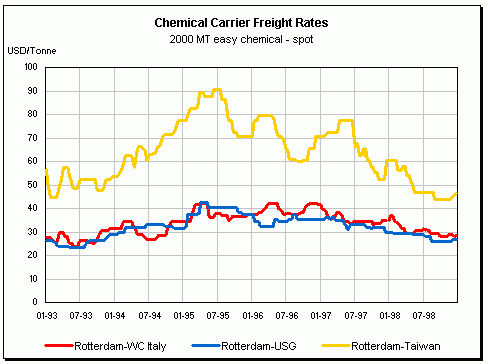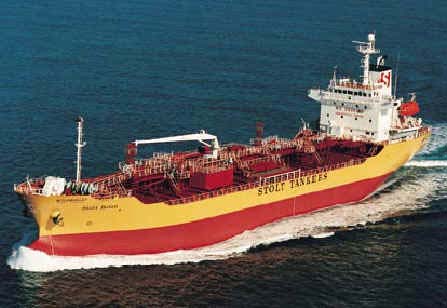| As mentioned above, the deep-sea markets were particularly depressed in
1998. The shipowners operating on these routes had to deal with a
tonnage overcapacity situation and with weak demand for transport to Asian destinations
following the economic crisis affecting this region of the globe for more than a year.
This year the freight rates on deep-sea markets reached their lowest
levels recorded since the beginning of the 1990s. Even though the slump in demand
originating in the Asian countries was the main cause of the weakness of the market, its
repercussions on freight rates were felt equally severely on the transatlantic market.
On this market the spot freight rates for 5000-tonne cargoes of easy
chemicals on a Rotterdam / Houston route fell to an average of $17.50/tonne compared with
about $22/tonne in 1997.
In the Houston / Rotterdam direction, the freight rates for 3000-tonne
cargoes fell by about 40%, from $40/tonne in 1997 to $25/tonne in 1998.
Nevertheless, it should be emphasized that although the decrease in
freight rates on the spot market was very large this year, the transatlantic market,
unlike the Asian markets, remains highly structured in contract terms. Furthermore, the
contracts were moving in the right direction this year.
On the ex-Europe market to the Asian countries, the freight rates for
2,000- to 3000-tonne cargoes decreased gradually by 35% to reach around $45/tonne at the
end of the year.
At time of writing the contract renewal rates for the Asian market
remained highly confidential.

The 1998 balance sheet for shipowners in the European coastal shipping
markets (inter-Northern Europe, Northern Europe / Mediterranean and return) was not as
catastrophic as it was for shipowners operating on the deep-sea routes. Although they
agree in recognizing a fall in results compared with 1997, most shipowners operating in
this region anticipated worse results given the decrease in volumes carried and a further
increase in competition. The main advantage of the majority of these owners is the high
level of contract coverage, often as much as 70% to 80% of the work, and their relatively
low exposure to the fluctuations of the spot market.
The results of these owners were also helped by the firmness of the
dollar against the European currencies and by the low bunker oil prices which contributed
to reducing operating costs.
The European coastal shipping market held up at the 1997 level until May
1998. A sharp fall occurred in May-June 1998 in both volumes and rates. This depression
persisted until the beginning of the autumn, but the slight volume recovery from the
second half of October was not enough to generate an increase in rates. On the spot market
the volume of European coastal shipping decreased by about half in 1998 and the freight
rates fell by 20% to 25%. On average, carrier contracts should be renewed with potential
reductions of 5% to 10% for 1999.
In conclusion, nobody expects an improvement in the freight market for
1999, and it may even be more difficult for the shipowners, many of whom will have to
accept contract rates revised downwards.
For the long term, and in particular on the market for large parcel
tankers on deep-sea routes, the owners remain fairly optimistic given the potential that
this market maintains in the future, particularly in Asia. Demand will continue to grow in
this region, but more slowly than over the last few years.
In parallel, the major newbuilding order programs now appear to be
coming to an end, and a recovery in activity can be predicted for the chemical carrier
market in 2000/2001, this phenomenon being accentuated by the recovery of the scrapping
market expected in 1999.
 |
Stolt Botan
chemical parcel tanker 11,200 dwt
blt 1998 by Fukoka
operated by Stolt-NYK |
|